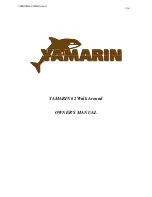
35
2. Starting Procedures
a. Release shaft lock, if so equipped.
b. Set controls in neutral.
c. Advance throttle slightly – approximately 1/4.
d. Turn ignition switch to ON and operate "starter".
NOTE
:
Some engines are equipped with "pre-heat". Check engine manual for instructions.
e. Operate engine about 1000 rpm. Check immediately for oil pressure reading.
f. Check for water discharge.
g. Check ammeter for "charge" indication.
h. Allow engine to reach normal operating temperature and observe any tendency to continue to
rise.
i. A final visual check of the engine room is recommended, as the engine is warming up.
j. Check forward and reverse operation at idle speed before casting off lines.
3. Engine Operation
a. Run engine at speeds as recommended in engine manual. Always reduce engine rpm to "idle"
before shifting, and make throttle adjustments gradually.
b. Observe engine instruments periodically.
c. Avoid long periods of maximum rpm, as well as extended "idle" periods. Always run engine
long enough to reach normal operating temperature, as short runs cause excess engine deposits
and sludge formation in oil.
d. Become familiar with the sound of your engine at its cruising speeds, and note any vibration
characteristics. When an abnormal sound or vibration occurs, reduce rpm and make a quick check
of instruments and conditions. Have problem checked as soon as possible.
e. Observe ammeter readings periodically; and as battery becomes charged (low charge rate), you
may switch over to the alternate or house battery.
CAUTION:
Do not turn the battery switch to OFF position while engine is running. To do so may
damage voltage regulators and possibly destroy diode rectifier in the alternator. It is advisable to
reduce rpm to idle if possible while switching batteries to prevent an unnecessary surge on the
system. The alternator should not be charging at maximum for long periods of time. If this occurs,
it is advisable to allow a cooling off period at 10-minute intervals, switching to the "charged"
battery or operating at lower rpm's.
4. Engine Shut-Down
a. Allow the engine to idle for a few minutes before stopping, and check instruments for proper
readings.
b. Push STOP control and hold until engine stops.
c. Turn ignition switch and blower switch OFF.
d. Close fuel valve and seacock if boat is to be left unattended.
e. Visually check engine room and bilges for leakage.
NOTE
: Check engine "hours" for maintenance scheduling. Read and use your engine manual.
Maintain an engine /maintenance log.
Содержание VANCOUVER 42
Страница 1: ...1 OPERATIONS AND MAINTENANCE MANUAL TAYANA VANCOUVER 42...
Страница 2: ...2 Tayana V 42 Center Cockpit Sailplan...
Страница 3: ...3 Tayana V 42 Aft Cockpit Interior Layout...
Страница 12: ...12 Figure II 1 Fiberglass Layout Schedule...
Страница 13: ...13 Figure II 2 V 42 Deck and Hull Joint...
Страница 19: ......
Страница 37: ...37 Figure IV 1 Fuel Supply Plumbing...
Страница 38: ...38 Figure IV 2 Fluid Plumbing System...
Страница 39: ...39 Figure IV 3 Center Cockpit Tankage Diagram...
Страница 43: ...43 TABLE IV 1 Direct Current Energy Audit...
Страница 48: ...48 Figure IV 6 Waste Water Plumbing System...
Страница 51: ...51 Figure IV 8 Propane System...
















































